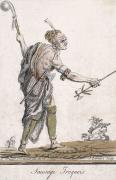
For a minute this morning, I asked myself if conservative New York Times columnist David Brooks might be about to follow Chris Hedges into the far left. Or perhaps wander off into the woods to find a commune.
Brooks has written an interesting column in which he suggests that maybe Americans, especially millennials, want more than material comforts in our highly individualistic society, that they want community.
His entrance into this topic is through a comparison of British colonial Native American and European communities living side-by-side in the eighteenth century. At that time, the Indians seldom if ever wanted to live in the European communities, but Europeans frequently and in significant numbers ran off to live with the indigenous people. “Why?” Brooks asks. Because they preferred the Indians’ community to colonial society.
Following this very promising beginning, however, Brooks fails to ask the key question—What was the basis of the Indians’ community? Instead he wanders off into the tepid, liberal utopianism of community self-help. as explained by John McKnight and Peter Block. We will not follow him there.
So, let’s ask the question Brooks failed to ask. What was the basis of the indigenous community? Native American communities in the Northeast in the colonial period at the time of arrival of the Europeans were sedentary agriculturalists who also engaged in hunting and gathering, all on a modest scale in comparison with earlier Mississippian culture and with the Maya, Aztec, and Incan peoples in the South.
The Northeastern indigenous people had not developed social classes. They had not developed a notion of private property in land and goods. They had not developed a state that rose above the society, as was the case in Central America, Mexico and Peru. Gender differences existed and men usually held the leadership positions, though, as in the case of the Iroquois, women could “knock their horns off” and remove them from office.
The Native Americans’ communities were attractive to Europeans because they had no rich and poor. No bosses. No standing army and no police. Men and women were more equal, and women were those who most wanted to say with the Indians, even if they had been their captors.
The indigenous peoples’ community was based on their sharing of the bounty of nature, their shared labor, and their shared social wealth. In many American indigenous societies, when some Indian became rich, he or she had to give away their belongings to the others, in what the Pacific Northest peoples’ called the potlatch.
The Native Americans’ societies were not exactly socialist or genuinely communist, but they were not far from it either. The colonial Europeans who went to live in the Indian villages wanted the community that came from socialism. And that, by the way, polls suggest, is what many of the millennials today want as well.
[The drawing is by Iroquois Native Canadian Indian Tattoo Artist: Grasset de Saint Sauveur Jacques, 1757-1810. Engraver: Mixelle, Jean-Marie active late 18th century. Credit: Library and Archives Canada.]
*Dan La Botz is a Co-Editor of New Politics.


Leave a Reply